Ivan V. Bajić
Semantics-Guided Generative Image Compression
May 29, 2025Abstract:Advancements in text-to-image generative AI with large multimodal models are spreading into the field of image compression, creating high-quality representation of images at extremely low bit rates. This work introduces novel components to the existing multimodal image semantic compression (MISC) approach, enhancing the quality of the generated images in terms of PSNR and perceptual metrics. The new components include semantic segmentation guidance for the generative decoder, as well as content-adaptive diffusion, which controls the number of diffusion steps based on image characteristics. The results show that our newly introduced methods significantly improve the baseline MISC model while also decreasing the complexity. As a result, both the encoding and decoding time are reduced by more than 36%. Moreover, the proposed compression framework outperforms mainstream codecs in terms of perceptual similarity and quality. The code and visual examples are available.
Rate-Accuracy Bounds in Visual Coding for Machines
May 20, 2025Abstract:Increasingly, visual signals such as images, videos and point clouds are being captured solely for the purpose of automated analysis by computer vision models. Applications include traffic monitoring, robotics, autonomous driving, smart home, and many others. This trend has led to the need to develop compression strategies for these signals for the purpose of analysis rather than reconstruction, an area often referred to as "coding for machines." By drawing parallels with lossy coding of a discrete memoryless source, in this paper we derive rate-accuracy bounds on several popular problems in visual coding for machines, and compare these with state-of-the-art results from the literature. The comparison shows that the current results are at least an order of magnitude -- and in some cases two or three orders of magnitude -- away from the theoretical bounds in terms of the bitrate needed to achieve a certain level of accuracy. This, in turn, means that there is much room for improvement in the current methods for visual coding for machines.
SplitFedZip: Learned Compression for Data Transfer Reduction in Split-Federated Learning
Dec 18, 2024Abstract:Federated Learning (FL) enables multiple clients to train a collaborative model without sharing their local data. Split Learning (SL) allows a model to be trained in a split manner across different locations. Split-Federated (SplitFed) learning is a more recent approach that combines the strengths of FL and SL. SplitFed minimizes the computational burden of FL by balancing computation across clients and servers, while still preserving data privacy. This makes it an ideal learning framework across various domains, especially in healthcare, where data privacy is of utmost importance. However, SplitFed networks encounter numerous communication challenges, such as latency, bandwidth constraints, synchronization overhead, and a large amount of data that needs to be transferred during the learning process. In this paper, we propose SplitFedZip -- a novel method that employs learned compression to reduce data transfer in SplitFed learning. Through experiments on medical image segmentation, we show that learned compression can provide a significant data communication reduction in SplitFed learning, while maintaining the accuracy of the final trained model. The implementation is available at: \url{https://github.com/ChamaniS/SplitFedZip}.
Learned Multimodal Compression for Autonomous Driving
Aug 15, 2024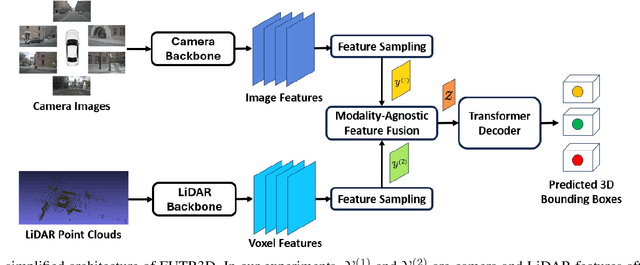
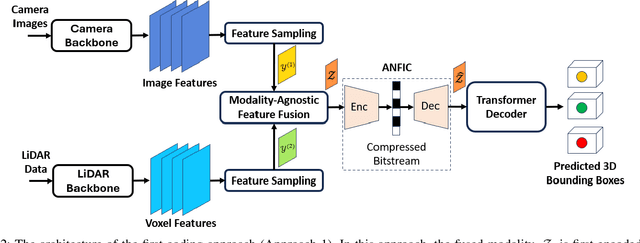

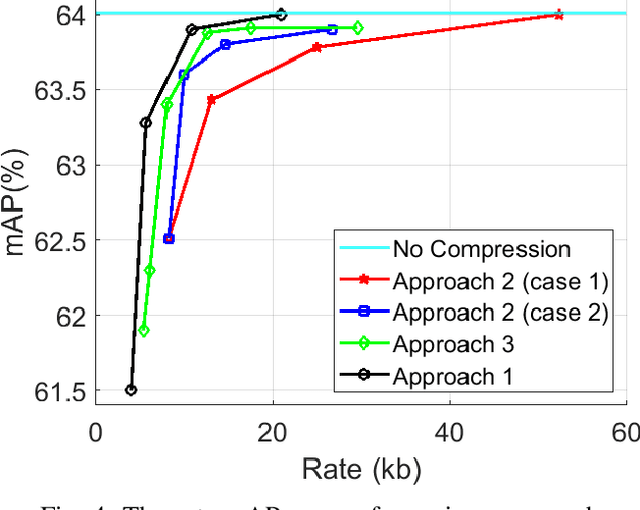
Abstract:Autonomous driving sensors generate an enormous amount of data. In this paper, we explore learned multimodal compression for autonomous driving, specifically targeted at 3D object detection. We focus on camera and LiDAR modalities and explore several coding approaches. One approach involves joint coding of fused modalities, while others involve coding one modality first, followed by conditional coding of the other modality. We evaluate the performance of these coding schemes on the nuScenes dataset. Our experimental results indicate that joint coding of fused modalities yields better results compared to the alternatives.
Learned Compression of Encoding Distributions
Jun 18, 2024Abstract:The entropy bottleneck introduced by Ball\'e et al. is a common component used in many learned compression models. It encodes a transformed latent representation using a static distribution whose parameters are learned during training. However, the actual distribution of the latent data may vary wildly across different inputs. The static distribution attempts to encompass all possible input distributions, thus fitting none of them particularly well. This unfortunate phenomenon, sometimes known as the amortization gap, results in suboptimal compression. To address this issue, we propose a method that dynamically adapts the encoding distribution to match the latent data distribution for a specific input. First, our model estimates a better encoding distribution for a given input. This distribution is then compressed and transmitted as an additional side-information bitstream. Finally, the decoder reconstructs the encoding distribution and uses it to decompress the corresponding latent data. Our method achieves a Bj{\o}ntegaard-Delta (BD)-rate gain of -7.10% on the Kodak test dataset when applied to the standard fully-factorized architecture. Furthermore, considering computational complexity, the transform used by our method is an order of magnitude cheaper in terms of Multiply-Accumulate (MAC) operations compared to related side-information methods such as the scale hyperprior.
Optimizing Split Points for Error-Resilient SplitFed Learning
May 29, 2024Abstract:Recent advancements in decentralized learning, such as Federated Learning (FL), Split Learning (SL), and Split Federated Learning (SplitFed), have expanded the potentials of machine learning. SplitFed aims to minimize the computational burden on individual clients in FL and parallelize SL while maintaining privacy. This study investigates the resilience of SplitFed to packet loss at model split points. It explores various parameter aggregation strategies of SplitFed by examining the impact of splitting the model at different points-either shallow split or deep split-on the final global model performance. The experiments, conducted on a human embryo image segmentation task, reveal a statistically significant advantage of a deeper split point.
Mutual Information Analysis in Multimodal Learning Systems
May 21, 2024
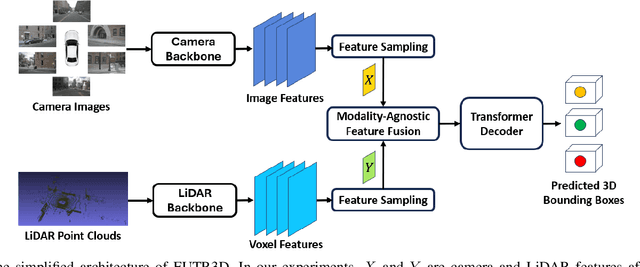
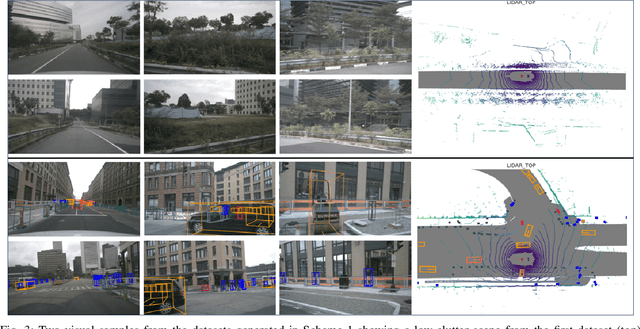
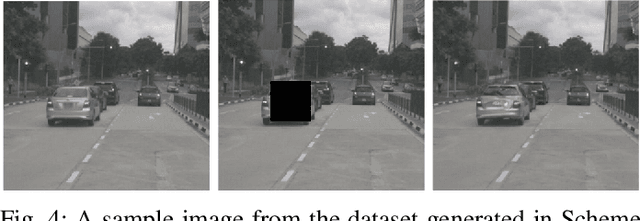
Abstract:In recent years, there has been a significant increase in applications of multimodal signal processing and analysis, largely driven by the increased availability of multimodal datasets and the rapid progress in multimodal learning systems. Well-known examples include autonomous vehicles, audiovisual generative systems, vision-language systems, and so on. Such systems integrate multiple signal modalities: text, speech, images, video, LiDAR, etc., to perform various tasks. A key issue for understanding such systems is the relationship between various modalities and how it impacts task performance. In this paper, we employ the concept of mutual information (MI) to gain insight into this issue. Taking advantage of the recent progress in entropy modeling and estimation, we develop a system called InfoMeter to estimate MI between modalities in a multimodal learning system. We then apply InfoMeter to analyze a multimodal 3D object detection system over a large-scale dataset for autonomous driving. Our experiments on this system suggest that a lower MI between modalities is beneficial for detection accuracy. This new insight may facilitate improvements in the development of future multimodal learning systems.
Compressive Feature Selection for Remote Visual Multi-Task Inference
May 15, 2024



Abstract:Deep models produce a number of features in each internal layer. A key problem in applications such as feature compression for remote inference is determining how important each feature is for the task(s) performed by the model. The problem is especially challenging in the case of multi-task inference, where the same feature may carry different importance for different tasks. In this paper, we examine how effective is mutual information (MI) between a feature and a model's task output as a measure of the feature's importance for that task. Experiments involving hard selection and soft selection (unequal compression) based on MI are carried out to compare the MI-based method with alternative approaches. Multi-objective analysis is provided to offer further insight.
Scalable Human-Machine Point Cloud Compression
Feb 23, 2024Abstract:Due to the limited computational capabilities of edge devices, deep learning inference can be quite expensive. One remedy is to compress and transmit point cloud data over the network for server-side processing. Unfortunately, this approach can be sensitive to network factors, including available bitrate. Luckily, the bitrate requirements can be reduced without sacrificing inference accuracy by using a machine task-specialized codec. In this paper, we present a scalable codec for point-cloud data that is specialized for the machine task of classification, while also providing a mechanism for human viewing. In the proposed scalable codec, the "base" bitstream supports the machine task, and an "enhancement" bitstream may be used for better input reconstruction performance for human viewing. We base our architecture on PointNet++, and test its efficacy on the ModelNet40 dataset. We show significant improvements over prior non-specialized codecs.
Learned Point Cloud Compression for Classification
Aug 11, 2023Abstract:Deep learning is increasingly being used to perform machine vision tasks such as classification, object detection, and segmentation on 3D point cloud data. However, deep learning inference is computationally expensive. The limited computational capabilities of end devices thus necessitate a codec for transmitting point cloud data over the network for server-side processing. Such a codec must be lightweight and capable of achieving high compression ratios without sacrificing accuracy. Motivated by this, we present a novel point cloud codec that is highly specialized for the machine task of classification. Our codec, based on PointNet, achieves a significantly better rate-accuracy trade-off in comparison to alternative methods. In particular, it achieves a 94% reduction in BD-bitrate over non-specialized codecs on the ModelNet40 dataset. For low-resource end devices, we also propose two lightweight configurations of our encoder that achieve similar BD-bitrate reductions of 93% and 92% with 3% and 5% drops in top-1 accuracy, while consuming only 0.470 and 0.048 encoder-side kMACs/point, respectively. Our codec demonstrates the potential of specialized codecs for machine analysis of point clouds, and provides a basis for extension to more complex tasks and datasets in the future.
 Add to Chrome
Add to Chrome Add to Firefox
Add to Firefox Add to Edge
Add to Edge